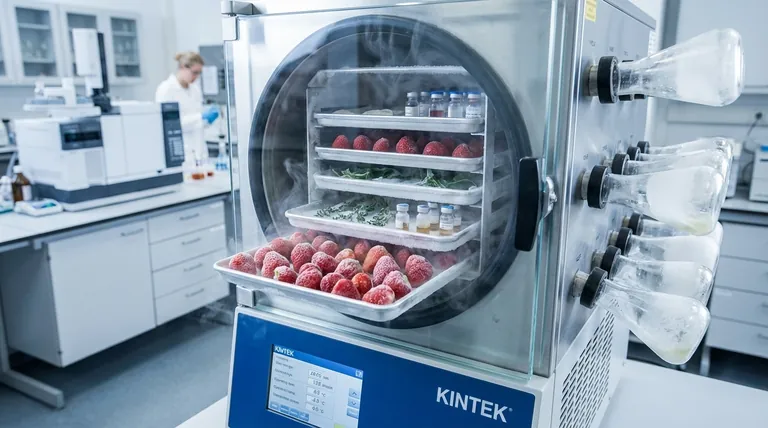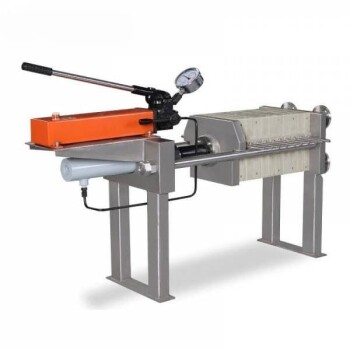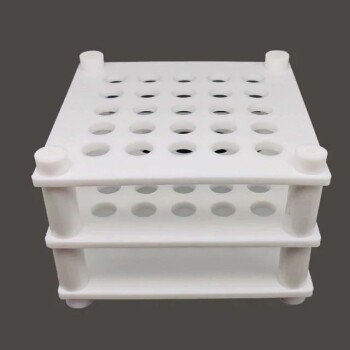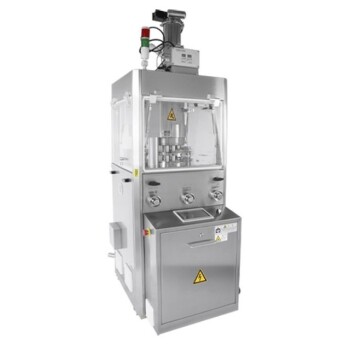The short answer is that freeze drying maintains product quality by removing water from a frozen state through a process called sublimation. This gentle technique avoids the high heat and liquid-to-gas transition of conventional drying, which damages a product's physical structure, degrades its flavor, and destroys heat-sensitive nutrients.
The critical difference lies in how water is removed. Conventional methods use heat to boil water away, causing the product's structure to collapse and shrink. Freeze drying uses a vacuum to turn solid ice directly into vapor, perfectly preserving the original shape, texture, and chemical integrity of the material.

The Fundamental Difference: Sublimation vs. Evaporation
To understand the quality difference, you must first understand the two distinct physical processes at play. The method of water removal is what determines the quality of the final product.
How Conventional Drying Works (Evaporation)
Conventional drying relies on evaporation. Heat is applied to a product to raise the temperature of its liquid water until it turns into vapor.
As this water leaves, the surface tension of the remaining liquid pulls on the product's cellular structure. This force causes the structure to collapse, leading to significant shrinkage, increased density, and a hardened texture.
How Freeze Drying Works (Sublimation)
Freeze drying, or lyophilisation, relies on sublimation. It is a three-stage process that bypasses the liquid phase of water entirely.
First, the product is frozen solid, locking its structure and all its components in place. Next, it is placed in a vacuum, where the pressure is lowered dramatically. In this low-pressure environment, the frozen water turns directly from a solid (ice) into a gas (water vapor), which is then removed. Finally, a secondary drying phase removes any remaining bound water molecules.
Because the water is removed from a solid, frozen matrix, it leaves behind a porous, unchanged structure.
The Key Quality Advantages of Freeze Drying
The gentle nature of sublimation directly translates into superior preservation across several key metrics, which is why it is essential for high-value materials from pharmaceuticals to specialty foods.
Unchanged Physical Structure and Texture
By avoiding the structural collapse caused by evaporation, freeze drying perfectly maintains the product's original size, shape, and texture.
This creates a lightweight, porous structure that is often crisp and airy, rather than the hard, dense result of conventional drying.
Superior Preservation of Flavor, Color, and Nutrients
Many compounds responsible for flavor, aroma, and nutritional value (like vitamins) are volatile and heat-sensitive.
The high heat of conventional drying destroys these delicate compounds. The low-temperature, low-pressure environment of freeze drying preserves them almost entirely, resulting in a product that retains its original sensory and nutritional profile.
Enhanced Stability and Shelf Life
By removing up to 99% of the water content, freeze drying effectively halts the biological and chemical processes that cause degradation.
This dramatic reduction in moisture inhibits the growth of bacteria, mold, and other microorganisms, giving products an exceptionally long and stable shelf life without the need for preservatives.
Rapid Reconstitution
The porous, sponge-like structure left behind by sublimation allows water to re-enter and rehydrate the product almost instantly.
Conventionally dried products, with their collapsed and dense structure, rehydrate slowly and often incompletely.
Understanding the Trade-offs
While freeze drying offers unparalleled quality preservation, it is not the ideal solution for every application. Objectivity requires acknowledging its significant operational demands.
Energy and Time Intensity
The multi-stage process of freezing, creating a deep vacuum, and slowly removing water vapor is far more time-consuming and energy-intensive than applying direct heat. A typical freeze-drying cycle can last for many hours or even days.
Equipment Cost and Complexity
Freeze dryers are sophisticated machines that require powerful refrigeration systems and high-capacity vacuum pumps. This specialized equipment is significantly more expensive to purchase, operate, and maintain than conventional ovens or dehydrators.
Making the Right Choice for Your Application
Choosing the correct drying method depends entirely on balancing your quality requirements against your operational and financial constraints.
- If your primary focus is preserving high-value, heat-sensitive materials: Freeze drying is the definitive choice for products like pharmaceuticals, live bacterial cultures, specialty coffee, and gourmet ingredients where original quality is paramount.
- If your primary focus is bulk dehydration with cost-efficiency: Conventional heat drying is the more practical and economical method for producing items like grain, lumber, or basic soup powders where some structural and nutritional loss is acceptable.
By understanding the core principle of sublimation, you can confidently choose the drying method that aligns perfectly with your product's quality targets and your project's budget.
Summary Table:
| Aspect | Freeze Drying | Conventional Drying |
|---|---|---|
| Process | Sublimation (ice to vapor) | Evaporation (liquid to vapor) |
| Temperature | Low (gentle, cold process) | High (uses heat) |
| Structure | Preserved, porous, no shrinkage | Collapsed, dense, shrinks |
| Nutrient/Flavor | Excellent preservation | Significant degradation |
| Reconstitution | Rapid and complete | Slow and often incomplete |
| Shelf Life | Exceptionally long | Standard |
Need to preserve the integrity of your high-value materials?
At KINTEK, we specialize in providing advanced freeze-drying solutions for laboratories that demand the highest quality preservation. Our equipment is designed to perfectly maintain the structure, flavor, and nutritional content of sensitive materials like pharmaceuticals, research samples, and specialty food products.
Let our experts help you choose the right freeze dryer to enhance your lab's capabilities and ensure the stability of your most critical samples.
Contact KINTEK today to discuss your specific laboratory needs and discover the benefits of our reliable freeze-drying systems.
Visual Guide

Related Products
- Benchtop Laboratory Freeze Dryer for Lab Use
- Benchtop Laboratory Vacuum Freeze Dryer
- Laboratory Sterilizer Lab Autoclave Pulse Vacuum Lifting Sterilizer
- Laboratory Sterilizer Lab Autoclave Vertical Pressure Steam Sterilizer for Liquid Crystal Display Automatic Type
- Laboratory Test Sieves and Sieving Machines
People Also Ask
- What is the primary function of a freeze dryer in a laboratory setting? Preserve Delicate Materials with Sublimation
- What role do laboratory freeze dryers play in the food industry? Unlock Superior Food Preservation
- What are some common uses of freeze drying? Preserve Delicate Materials with Precision
- What is the purpose of laboratory freeze drying? Preserve Sensitive Drugs & Biologics for Stability
- What role does freeze drying play in scientific research? Preserve Sample Integrity for Reliable Results



















